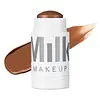What's inside
What's inside
 Key Ingredients
Key Ingredients

 Benefits
Benefits

 Concerns
Concerns

 Ingredients Side-by-side
Ingredients Side-by-side

Ethylhexyl Palmitate
EmollientTitanium Dioxide
Cosmetic ColorantCaprylyl Methicone
Skin ConditioningC10-18 Triglycerides
EmollientMethyl Methacrylate Crosspolymer
Mica
Cosmetic ColorantPolysilicone-11
Silica
AbrasiveCera Microcristallina
Emulsion StabilisingSynthetic Wax
AbrasiveCyclopentasiloxane
EmollientAlumina
AbrasivePentaerythrityl Tetrabehenate
EmollientCaprylic/Capric Triglyceride
MaskingTridecyl Trimellitate
EmollientButyloctyl Salicylate
Skin ConditioningLauryl PEG-10 Tris(Trimethylsiloxy)Silylethyl Dimethicone
EmulsifyingParaffin
PerfumingPolymethylsilsesquioxane
Tristearin
Skin ConditioningPhenoxyethanol
PreservativeAluminum Hydroxide
EmollientTriisostearyl Citrate
EmollientMagnesium Myristate
Triethoxycaprylylsilane
Ethylhexylglycerin
Skin ConditioningLaureth-12
EmulsifyingJojoba Esters
EmollientOctyldodecanol
EmollientHelianthus Annuus Seed Wax
Skin ConditioningEchium Plantagineum Seed Oil
Skin ConditioningAcacia Decurrens Flower Wax
EmollientPolyglycerin-3
HumectantHelianthus Annuus Seed Oil Unsaponifiables
EmollientCardiospermum Halicacabum Flower/Leaf/Vine Extract
Skin ConditioningTocopherol
AntioxidantIron Oxides
Ethylhexyl Palmitate, Titanium Dioxide, Caprylyl Methicone, C10-18 Triglycerides, Methyl Methacrylate Crosspolymer, Mica, Polysilicone-11, Silica, Cera Microcristallina, Synthetic Wax, Cyclopentasiloxane, Alumina, Pentaerythrityl Tetrabehenate, Caprylic/Capric Triglyceride, Tridecyl Trimellitate, Butyloctyl Salicylate, Lauryl PEG-10 Tris(Trimethylsiloxy)Silylethyl Dimethicone, Paraffin, Polymethylsilsesquioxane, Tristearin, Phenoxyethanol, Aluminum Hydroxide, Triisostearyl Citrate, Magnesium Myristate, Triethoxycaprylylsilane, Ethylhexylglycerin, Laureth-12, Jojoba Esters, Octyldodecanol, Helianthus Annuus Seed Wax, Echium Plantagineum Seed Oil, Acacia Decurrens Flower Wax, Polyglycerin-3, Helianthus Annuus Seed Oil Unsaponifiables, Cardiospermum Halicacabum Flower/Leaf/Vine Extract, Tocopherol, Iron Oxides
Ricinus Communis Seed Oil
MaskingC12-15 Alkyl Benzoate
AntimicrobialHelianthus Annuus Seed Oil
EmollientHelianthus Annuus Seed Wax
Skin ConditioningCoconut Alkanes
EmollientSilica
AbrasiveEuphorbia Cerifera Wax
Kaolin
AbrasiveMangifera Indica Seed Butter
Skin ConditioningCitrus Aurantium Dulcis Peel Wax
Skin ConditioningPrunus Armeniaca Kernel Oil
MaskingCoco-Caprylate/Caprate
EmollientBis-Stearyl Dimethicone
EmollientParfum
MaskingHydrogenated Vegetable Oil
EmollientIsopropyl Titanium Triisostearate
EmollientTocopheryl Acetate
AntioxidantSorbitan Tristearate
EmulsifyingCI 77891
Cosmetic ColorantIron Oxides
Ricinus Communis Seed Oil, C12-15 Alkyl Benzoate, Helianthus Annuus Seed Oil, Helianthus Annuus Seed Wax, Coconut Alkanes, Silica, Euphorbia Cerifera Wax, Kaolin, Mangifera Indica Seed Butter, Citrus Aurantium Dulcis Peel Wax, Prunus Armeniaca Kernel Oil, Coco-Caprylate/Caprate, Bis-Stearyl Dimethicone, Parfum, Hydrogenated Vegetable Oil, Isopropyl Titanium Triisostearate, Tocopheryl Acetate, Sorbitan Tristearate, CI 77891, Iron Oxides
Alternatives
Ingredients Explained
These ingredients are found in both products.
Ingredients higher up in an ingredient list are typically present in a larger amount.
Helianthus Annuus Seed Wax is created from the common sunflower.
Sunflower seed wax is made up of long chain non-glyceride esters, a small amount of fatty alcohols, and fatty acids.
This ingredient is often used to enhance the texture of products. The fatty acid properties also help hydrate the skin.
Learn more about Helianthus Annuus Seed WaxSilica, also known as silicon dioxide, is a naturally occurring mineral. It is used as a fine, spherical, and porous powder in cosmetics.
Though it has exfoliant properties, the function of silica varies depending on the product.
The unique structure of silica enhances the spreadability and adds smoothness, making it a great texture enhancer.
It is also used as an active carrier, emulsifier, and mattifier due to its ability to absorb excess oil.
In some products, tiny microneedles called spicules are made from silica or hydrolyzed sponge. When you rub them in, they lightly polish away dead skin layers and enhance the penetration of active ingredients.
Learn more about SilicaThis ingredient is a combination of red, black, and yellow iron oxide pigments. This combination of colors is usually found in foundation, because it results in a "skin" color.